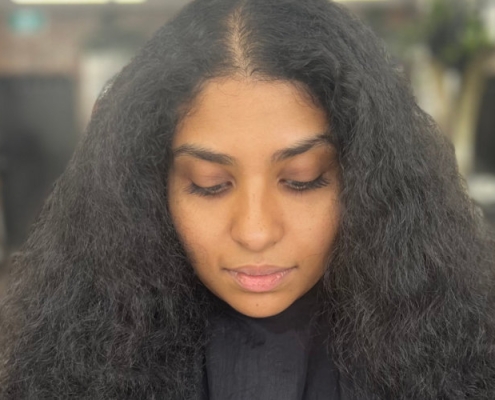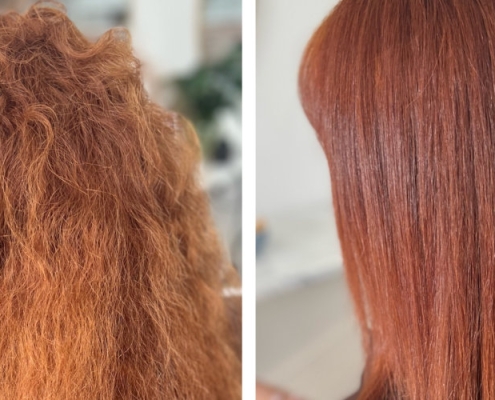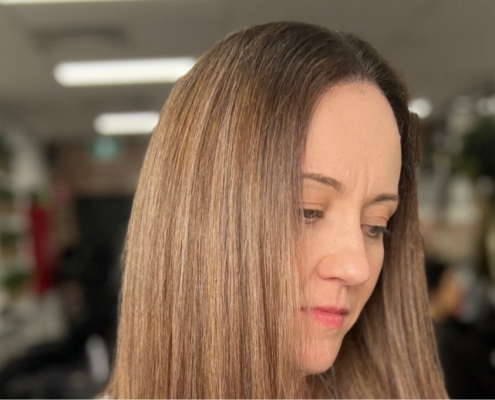Why Your Nanoplasty Didn’t Work (and How to Get It Right)
Nanoplasty has quickly become one of the most requested smoothing treatments for those seeking sleek, frizz-free, and manageable hair — without the harsh chemicals associated with traditional keratin. But what happens when the results don’t match the promise?
If your Nanoplasty didn’t last, left your hair feeling dry or brittle, or didn’t give you that smooth, glossy finish you were hoping for, you’re not alone. Every week at The Cutting Room, we hear from clients who’ve had disappointing experiences elsewhere.
Here’s what we want you to know: when Nanoplasty doesn’t work, it’s rarely because the treatment itself is flawed — it’s almost always due to poor application, incorrect technique, or lack of professional knowledge.
Let’s break down the most common reasons your Nanoplasty didn’t deliver the results you expected — and how to make sure your next treatment gives you the beautiful, long-lasting transformation it should.
1. It Wasn’t Done by a Qualified Hairdresser
Nanoplasty isn’t something that can be mastered in a weekend course. It requires more than just following basic instructions — it demands a strong understanding of hair biology, chemistry, and styling techniques.
We’re seeing more and more people offering Nanoplasty without being licensed hairdressers. Some of them advertise services from home salons, relying on social media testimonials instead of real credentials. While their prices may be tempting, the risks are high — especially when your hair’s health is on the line.
Nanoplasty isn’t just “paint on, flat iron, done.” It takes:
- A deep understanding of hair structure and condition
- The ability to tailor the treatment to different hair types (curly, coloured, damaged, fine, thick, etc.)
- Careful control of heat, timing, and product saturation
In untrained hands, even the best Nanoplasty product can lead to poor results — or worse, hair damage. If your hair felt dry, brittle or broke after your treatment, there’s a good chance the application wasn’t done properly.
At The Cutting Room, our team consists of experienced, professionally trained stylists who have performed over 3,000 Nanoplasty treatments. We assess every strand of your hair — from porosity and density to colour history and heat sensitivity — before even starting the treatment.
If your Nanoplasty was performed by someone without that level of knowledge, it may not have penetrated the hair properly, been sealed correctly, or matched your hair’s specific needs — leading to disappointing (and sometimes damaging) results.
Learn more about the risks of choosing unqualified providers in The Dangers of DIY Nanoplasty.
2. The Wrong Heat Setting Was Used
One of the most damaging mistakes we see is the use of excessive heat — particularly flat irons set to 250°C or more. That level of heat can literally burn your hair, especially if it’s fine, coloured, bleached, or chemically processed.
Nanoplasty needs to be sealed with heat, yes — but the temperature must be carefully adjusted based on hair type and condition. Using too much heat can:
- Break down essential protein structures in the hair
- Cause irreversible damage and breakage
- Leave the hair dry, fragile, and prone to snapping
In contrast, using too little heat means the treatment won’t seal properly — which can make it appear as if Nanoplasty “didn’t take” or “washed out.”
Heat control is critical — and only experienced stylists understand how to customise it for best results. More signs of heat damage and incorrect application are covered in our post Signs Your Nanoplasty Was Done Wrong.
3. It Didn’t Last Because It Wasn’t Applied Correctly
Done right, Nanoplasty should last 5 to 7 months — not 5 to 7 weeks. If your hair became frizzy again after only a few washes, it may be because:
- The product wasn’t evenly or thoroughly applied
- Processing time was too short
- Excess product was rinsed out prematurely
- The hair wasn’t properly clarified beforehand
Even small missteps in application can affect the end result. At The Cutting Room, we ask clients to arrive with clean, dry hair that has been shampooed 48 hours prior — this allows us to begin treatment on hair that’s free of heavy product buildup, without overstimulating the scalp. We don’t clarify the hair immediately before treatment, as that can lead to unnecessary irritation while Nanoplasty processes.
If a stylist skips this kind of preparation guidance or starts the service on hair that hasn’t been properly prepped, the product may not bond as effectively — leading to shorter-lasting results.
Read more in our blog: Does Nanoplasty Really Last?
4. You Weren’t Given Proper Aftercare Instructions
One of the most overlooked parts of Nanoplasty is what happens after you leave the salon. Many people assume it’s a “set-and-forget” treatment — but that’s not entirely true.
To preserve your results and avoid premature fading, it’s important to:
- Use sulfate-free, silicone-free shampoo and conditioner
- Avoid heat styling with no protection
- Delay colouring, bleaching, or chemical services for a few weeks post-treatment
- Minimise exposure to chlorinated or salt water without proper protection
Sadly, some salons skip this crucial education step, or worse — give incorrect advice that leads to clients unknowingly undoing their results.
For a full breakdown of what to do (and not do), visit our guide: Expert Aftercare Tips for Nanoplasty.
5. Your Hair Type Wasn’t Properly Assessed
Every head of hair is unique — and Nanoplasty must be customised accordingly. If your hair was bleached, highlighted, chemically processed, or naturally curly, a stylist needs to evaluate how those factors affect treatment timing, product concentration, and heat use.
For example:
- Coloured or bleached hair requires gentler heat and longer processing
- Very curly hair may show a “regrowth” look after a few months
- Fine or thinning hair needs lighter application and more attention to timing
If your stylist didn’t ask about your hair history, or didn’t tailor the treatment to your needs, it could explain why your results were underwhelming.
Learn more about how Nanoplasty works on different textures in our article: Nanoplasty for Different Hair Types.
6. You Didn’t Know What to Expect (Because No One Told You)
If your stylist promised pin-straight hair with zero effort and no follow-up — that was a red flag. While Nanoplasty delivers fantastic results, it’s important to understand what it can and can’t do:
- It will smooth, de-frizz, and soften your hair
- It will relax curls — it does not preserve your natural curl pattern
- Results are instant and visible on the day
- On blonde/lightened hair, it may cause slight tonal shifts (which we know how to minimise)
Our blog explains this clearly: Will Nanoplasty Affect My Hair Colour?
The takeaway? Set realistic expectations and choose a stylist who’s upfront and honest about the process.
How to Get It Right Next Time
Here’s what we recommend to anyone who’s had a bad experience elsewhere:
- Choose a salon that specialises in Nanoplasty
- Ensure your stylist is a qualified hairdresser, not just product-trained
- Ask questions before booking — like the ones we’ve outlined here: 7 Questions to Ask Before Booking Nanoplasty
- Follow expert aftercare advice and avoid shortcuts
- Remember: the right technique matters more than the product
Book Your Next Nanoplasty with Confidence
If your last Nanoplasty left you disappointed, don’t write it off. The treatment itself is powerful — it just needs the right hands.
At The Cutting Room, we’re trusted by clients across Sydney to deliver beautiful, consistent, long-lasting results — safely and professionally.
Book your consultation today and discover how Nanoplasty is supposed to feel.











